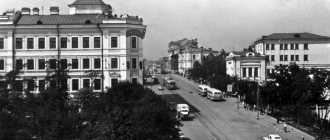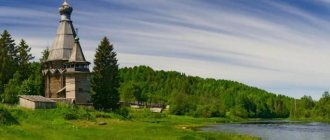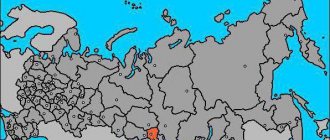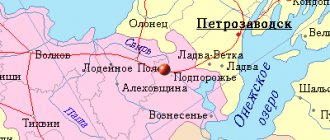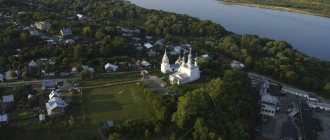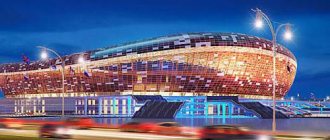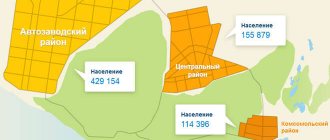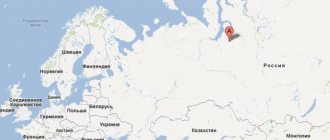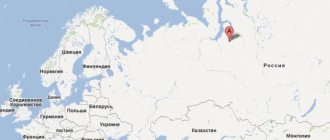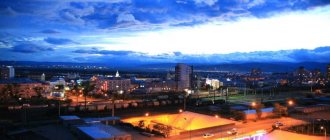Not thousands, but millions of tourists visit Vladivostok every year, and this is not surprising. The city attracts with its historical and cultural heritage; everyone is interested in seeing the “Pacific gates of Russia” with their own eyes. We will tell you about Vladivostok: what region or region it is, interesting facts about its history, what kind of people live here and what is definitely worth seeing in the famous Porto Franco.
How did Vladivostok appear?
Without delving into ancient history, we note that before the signing of the Aigun Treaty in 1858, Primorye belonged to China. Russia owes the annexation of lands to Count Nikolai Muravyov-Amursky, the Governor-General of Eastern Siberia, who immediately began searching for a place to create a Far Eastern stronghold.
The convenient, well-sheltered harbor in Peter the Great Bay was ideally suited for these purposes, and since 1859, newspapers have been reporting on a new Russian bay called Vladivostok, made up of two words: “own” and “East.”
The first settler arrived here in 1861. This was the merchant Yakov Semenov, who became the head of the post in 1870, and a year later the Siberian military flotilla was transferred here.
According to the 1878 census, 4,163 people already lived in the territory of the main port. If you are wondering what region of Russia Vladivostok belonged to then, the answer is simple. In 1880, the bay received the status of a city, which became the administrative center of the Primorsky region.
Section 1. General description of the locality
Even for residents of Russia, the center of the Primorsky Territory, Vladivostok, seems to be, as they say, at the edge of the earth.
Indeed, if you look at it, everything here is completely different: the time, the terrain, the habits of the local residents, and even street advertising.
Although if you imagine where Vladivostok is, everything will actually fall into place. Initially, the city was built on the Muravyov-Amursky Peninsula, but over time its territory expanded to the islands of the Sea of Japan, located in a bay with a very symbolic name named after Peter the Great.
This city is very unique. It is often compared to San Francisco. All this thanks to the bridge built across the Golden Horn. Vladivostok is acquiring a futuristic image. Light Asian exoticism, represented by right-hand drive cars and a mixture of hieroglyphs and Cyrillic alphabet, is all commonplace for a city like Vladivostok (the region, by the way, is also no exception).
But, despite all this, the administrative center is a romantic settlement. The location of the city dictates its own conditions: at any time of the year, incredible, breathtaking, almost picturesque views open here. And from above, the city actually resembles Japanese prints or films about the city of the future.
Rise, decline and rebirth
The city developed rapidly, and by 1897 more than 28 thousand people already lived here, and by the revolution the number of residents increased 3 times!
The duty-free porto-franco regime was introduced in Vladivostok in 1907, and the city experienced a real flourishing of trade and culture. And everything was fine, if not for the events of the October Revolution and the partisan war that broke out in the Far East, which tormented Primorye until the end of 1922.
During this period of time, Czechoslovak, American, Canadian, Italian and Japanese troops visited the city with the goal of overthrowing Soviet rule in Vladivostok. It is difficult to imagine which region or region was subjected to the same invasion and plunder. But the government of the young Soviet Republic implemented a multi-year plan to restore the city, which became the industrial center of the Far East.
At the same time, a transformation of administrative units took place, which affected the city of Vladivostok. There was no point in asking what area he belonged to. In 1922, the Primorsky region was abolished, and in 1938 the Primorsky Territory was formed with the administrative center in Vladivostok.
During the Second World War, the city did not participate in hostilities, but was constantly under the threat of attack by the Japanese. But here, the first in the whole country to establish a Defense Fund, which received funds for front-line needs, and the city made a huge contribution to the implementation of the American Lend-Lease program.
“Today, a free port and priority development areas only create unnecessary problems” (about new economic instruments)
— Is it possible to sum up some intermediate results of the work of such experimental mechanisms as priority development territories, the free port of Vladivostok, the Far Eastern hectare?
— Open the law on priority development areas - there is simply no goal there! Free port law? After comments from the public, the authors “excused themselves” with as many as five goals: deepen, expand, ensure...
The problem of infrastructure development in the Far East faces all regions without exception. Photo: PrimaMedia news agency
Anyone who comes with 5 million rubles becomes a resident of the free port. Each claims part of the coastal territory. And when we understand that the region and the country need to create a large port (not like today - for 20-50 million tons, but for 200-300 million tons, comparable to Busan, Shanghai, Hong Kong), then it turns out that there are no free territories , which, in fact, is already encountered today in the Nadezhdinskaya ASEZ. Preferential regimes are established by the state, and the state has the right to dictate what types of activities and production it intends to create here. When I claim that there is no state strategy here, I proceed from the fact that the criteria for selecting residents of priority development areas and free ports are such that anyone can come and do whatever they want within the limits limited by law. But this is the absence of a national goal, precisely formulated tasks. They talk about the transit function, but the total cargo turnover of all ports of the Far East is not comparable to one South Korean port! Our Trans-Siberian Railway is the shortest route from Asia to Europe, but over the past decades tariffs have only increased, and nothing else has happened. This route could become our “Silk Road”, but the Trans-Siberian Railway needs reconstruction.
- Plus - the second stage of BAM...
- Of course. I am still amazed: the Trans-Siberian Railway was built in almost 10 years. But over the past three decades, the speed has not increased; throughput is limited to 100 million tons. The President sets the goal of bringing it to 160–180 million tons, but given the current speed regime, this does not qualitatively change the situation. Let’s imagine that we managed to increase the speed of the Trans-Siberian Railway to 200 km per hour - how many days will it take for cargo from Japan or Korea to reach Europe?
Let's return to the laws on priority development areas and the free port of Vladivostok. By creating preferential treatment for investors, the state assumed obligations to provide the territory with primary infrastructure. 18 priority development areas were created, and the number of municipalities with the status of “Free Port of Vladivostok” increased from 7 to 21. Residents counted on future infrastructure. Four years have passed and a quarter of the state’s obligations have been fulfilled. What to do: by saving on benefits, build the infrastructure yourself?
In 2014, the governor of Primorsky Krai initiated an agreement with four municipalities to coordinate activities within the Vladivostok agglomeration. The idea was grandiose, and besides, all participants entered the free port, there was hope that work would begin according to a single agreed plan. No - some go to the forest, some for firewood. Each resident has his own strategy; all that is needed from the state are benefits and infrastructure. But doesn’t the country need modern, technologically advanced, competitive ports, doesn’t it need a national shipping company, synchronization of the work of ports and railways, powerful logistics centers? Are there really enough reports on the number of residents, abstract trillions in letters of intent? And this is what they want to “feed” us for 70 years, but in the next 10 years we would like to see operating new ports, hundreds of container ships, and increased well-being of the people living here. This is exactly how preferential treatment is supposed to work.
The idea of the priority development territories was to stimulate production and create competitive export products. Try to find among the residents of priority development areas those who are focused on the foreign market! Well, perhaps only in terms of purchasing raw materials or components. What raw materials are used to make the products of one of the first residents, Europlast, and who is it ahead of? Or Sollers with a screwdriver assembly...
It seems that good intentions in the form of a free port and priority development areas are creating new problems. Our children and grandchildren will disentangle them, remembering us with an unkind word.
The Far Eastern hectare is a task of the 19th century: the country is 90% peasant, and those who received freedom and allotment began to divide it into sons, each of whom only had somewhere to put his foot. And here they offer up to 100 dessiatines and support... But who can be attracted by this today? And where does such “generosity” come from - a whole hectare? The idea was to allow for population growth, but most (over 80%) of the land was taken by the people already living there. And even then, it would be understandable that if the cities here were overpopulated, some part would be delayed. But no - there are already so few people, and we are still losing them in the open spaces, occupying them with unproductive labor.
Closing of Vladivostok for foreigners
The strategically important eastern stronghold of the USSR has always been under the close attention of the country's top leadership, and since January 1, 1952, the city has been closed to foreigners. Even if foreign tourists knew what region Vladivostok was located in, when they tried to enter they were turned back.
Remember the phrase from Vysotsky’s song: “The closed port of Vladivostok is open”? Vladimir Semenovich then had domestic flights in mind, and Boris Nikolayevich Yeltsin opened the city for foreigners only in 1991.
The consequences of the collapse of the USSR greatly undermined the city's economy. The defense industry lost customers, and seafood from the “fish capital” went to Japan, poaching, smuggling of timber and Japanese cars flourished. Residents of the city moved en masse to the central regions, and only at the beginning of the 21st century did Vladivostok begin to get back on its feet.
Modern Vladivostok
The world was changing, and Vladivostok along with it. Which region or region it is may well not be known in other cities. However, residents of Primorye are probably aware of the peculiarities of the toponymy of Vladivostok. This is an area of 331.16 km2, which includes the Muravyov-Amursky Peninsula, the Peschany Peninsula and approximately 50 islands of Peter the Great Bay. As of 2022, 604 thousand 901 people live in the city.
It is interesting that compared to the 19th century, the ethnic composition of the population of Vladivostok has changed greatly. At that time, less than half of the city’s residents were Russians, and most of the city’s residents were Japanese, Chinese and Koreans. Today there are more than 475 thousand Russians in Vladivostok, Ukrainians are in second place (about 10.5 thousand people), Uzbeks are in third place (slightly more than 7 thousand people).
In general, this city is considered multinational, because in total representatives of 70 nationalities live here, and every citizen can be proud that he lives in Vladivostok.
What areas are the fastest to get here from? From Amur, Magadan and Sakhalin, as well as from Khabarovsk and Kamchatka territories. People come to Vladivostok to study, work and, of course, relax.
“The Amur region needs access to the sea” (about adjusting the borders of the Far Eastern regions)
— In November, at the Institute of Socio-Political Research of the Russian Academy of Sciences in Moscow, I proposed discussing the issue of the subjects of the Far East.
The area of the Khabarovsk Territory is about 800 thousand square meters. km. Its three northern districts make up more than half of the region, and only 10.5 thousand people live in them. From Khabarovsk to Okhotsk - 1600 km. How often do governors visit there?
The Chukotka Autonomous Okrug is equal in area to the Volga Federal District, which includes 14 federal subjects and four cities with a population of more than a million. In Chukotka there are barely 50 thousand people (in the city of Arsenyev there are more). Chukotka was once part of the Magadan region. It might be worth returning to this option. And if we add here the two northern districts of the Khabarovsk Territory - Ayano-Maisky and Okhotsky, we get 1.5 million square meters. km with a population of about 200 thousand people - the “Kolyma region” with the same natural conditions, a sparse population and a center in Magadan. This will make it possible to more effectively form the regional budget and develop all-weather modes of transport: helicopters, airplanes, ekranoplanes, airships, etc.
Another northern district of the Khabarovsk Territory - Tuguro-Chumikansky - logically fits into the territory of the Amur region, providing it with access to the sea. What are the hydraulic builders of the Zeya and Bureyskaya hydroelectric power stations doing today? But the project of a tidal power station in the area of the Shantar Islands remains relevant - an energy center that will allow the development of currently inaccessible territories. The north of the Far East is rich in deposits - this is our second Urals. But its development is hampered by a shortage of electricity. Changing the borders between the subjects opens up prospects for the Amur region, and gives a powerful impetus to economic development to the north of the Far East.
What is Khabarovsk Territory losing? Three northern regions. But it’s high time to include (or rather, return) the Jewish Autonomous Region. The EAO gains nothing from autonomy, while as part of the Khabarovsk Territory this territory has a chance.
— What do you think about the strange idea, given the transport gap, to unite Primorye and Sakhalin?
“There’s fish there, and there’s fish here” is a weak argument. So we can reach unification with Kamchatka... Vladimir Putin’s answer to the question of whether to annex Sakhalin to Primorye or not once again convinces me of the state’s uncertainty regarding the strategy in the east of the country. The President said that this was “an internal matter between the two regions.” But what comes first - government policy or the interests of private business or the population living here? If the feasibility of territorial transformations is justified not only by budgetary efficiency or military necessity, but also by an improvement in the socio-economic situation, then this needs to be explained to people. And when they are told: you decide for yourself... It is clear why the Sakhalin residents opposed the unification with Primorye: no one explained to them why this was.
Winter fishing championship on Sakhalin. Photo: PrimaMedia news agency
— Khabarovsk residents were against moving the center of the Far Eastern Federal District to Vladivostok, which is also understandable: this will hardly give anything to Vladivostok, and Khabarovsk is threatened with provincialization... It turns out that the state is eliminating itself, leaving the solution of such issues to commercial or political influence groups capable of orchestrating a regional a referendum in their own private interests? And by the way: what was the point in transferring Buryatia and the Trans-Baikal Territory from under the wing of the Siberian Federal District to the Far Eastern?
— For Acting Governor of Transbaikalia Alexander Osipov, former first deputy head of the Ministry of Eastern Development and one of the authors of the idea of priority development territories, it is important to receive the same preferential treatment to attract investors who operate in the Far East.
— What prevents you from simply extending the scope of priority development zones to Transbaikalia without changing the boundaries of federal districts?
— Nothing interferes; today the regime of priority development zones for some central regions of Russia is being discussed. In addition, let us remember that in many perspective documents Transbaikalia was considered together with the Far East.
Port, naval base and more
Throughout its existence, Vladivostok has been and remains the most important strategic facility with increased defense capability due to the main base of the Russian Pacific Fleet.
Vladivostok is connected to the Sea of Japan by the Amur and Ussuri gulfs. The most important Pacific sea routes for the country’s economy pass here, providing trade links with hundreds of countries around the world. The city is also the largest financial and cultural center of the Far East.
What else is remarkable about the city, which has grown from a small stronghold? This is interesting!
- Sollers automobile plant, manufacturer of Mazda and Toyota.
- Shipbuilding enterprises “Dal.
- Fish processing plants, for example, Dalryba and Dalmoreproduct.
- Far Eastern Federal University, many other universities and their branches.
- Primorsky Oceanarium.
- Primorsky State Art Gallery.
- 5 professional theatres, 21 cinemas, a circus.
If you are traveling to Vladivostok, which region or region you are going to visit, it won’t hurt to know, at least for correctly filling out business documents and so as not to offend Vladivostok residents with your ignorance. State competently: “Vladivostok is the administrative center of the Primorsky Territory!” And enjoy the cultural life of the city, which amazes with its diversity.
Festivals, forums and holidays are held here every year; residents of the city never get bored, and guests are recommended to visit local attractions.
